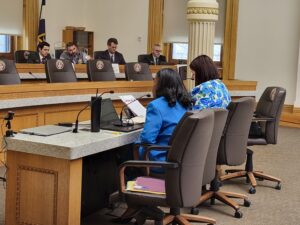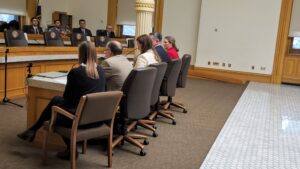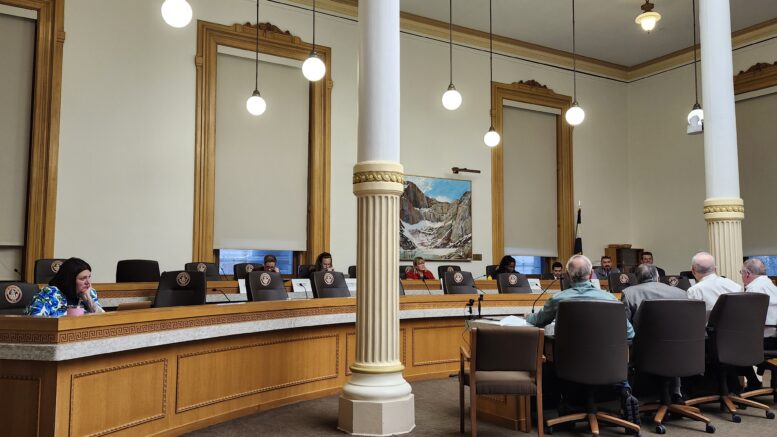A Colorado House committee advanced the first bill out of a set of significant air-quality proposals Thursday — a measure that that would ramp up permitting requirements on oil-and-gas facilities specifically along the northern Front Range.
House Bill 1330 would increase modeling requirements for any new or expanding facility that emits pollutants in the U.S. Environmental Protection Agency-determined ozone nonattainment area running from Douglas County north to the Wyoming border. It also would mandate state regulators include pre-production fracking emissions when evaluating permit applications, require the state to aggregate emissions of different wells in the same drilling area and bar issuance of new permits in the nonattainment area unless applicants remove as many emissions as new development proposes to add.
It is part of a “system-changer” package of bills that sprang from an interim committee that studied ways to reduce ozone pollution, which also includes measures to bar summertime drilling and to create a new “repeat violator” status for companies that carries heavy fines. Combined with other proposals that would ban new oil-and-gas drilling beginning in 2030 and impose significant new regulations on large manufacturing facilities, the bills are painted as air cleaners by proponents and job killers by many business groups.
Targeting air-quality permitting
HB 1330, sponsored by Democratic Reps. Jennifer Bacon of Denver and Jenny Willford of Northglenn, seeks to close what Willford called loopholes in state law that allow issuance of permits for new emitters as the state is under federal mandate to cut ozone pollution. Those loopholes include counting drilling wells individually as minor emitters rather than aggregately as major emitters, failing to count pre-production fracking emissions and letting wells begin drilling before securing Colorado Air Pollution Control Division permits.
“We do not intend to put the oil and gas industry out of business,” Willford told the House Energy & Environment Committee. “We do not debate that we have the strongest oil and gas regulations in the nation. But frankly, it’s not enough.”

Colorado state Reps. Jennifer Bacon and Jenny Willford explain their air-quality permitting bill to the House Energy & Environment Committee on Thursday.
Oil and gas industry leaders agreed that the bill wouldn’t directly put companies out of business, unlike Senate Bill 159, which is scheduled for its first hearing on March 14. But additional regulations would gum up a permitting process that now can stretch past 600 days in such a way that energy companies likely would look to invest more in other states and pull back on jobs and spending that drive a $48 billion economic sector in Colorado.
A slowdown to permitting process?
While not taking a position on the bill, Colorado state regulators seemed to corroborate that argument by noting that they believe they’ll need $24.8 million to beef up staff and implement the new mandates, rather than the $4 million set aside for them. APCD director Michael Ogletree noted that the department would have to model even for modifications that could decrease emissions, and deputy director Sergio Guerra said the cumulative modeling required by aggregating minor sources would create a “much more complex” system for the division to implement.
“As written, the bill would grind air permitting to a halt in Colorado, which I have to believe is the purpose of this bill,” Dan Haley, president/CEO of the Colorado Oil & Gas Association, told the committee.
In April 2022, the EPA downgraded the northern Front Range from a “serious” to a “severe” violator of ozone limits, which will require sales of expensive reformulated gas in summer months beginning in June and impose regulations on smaller emitters. Meanwhile, the nonattainment area has seen a spate of ozone-alert days — including 73 in 2021 and 41 even during the pandemic shutdown summer of 2020 — and bill sponsors say health in their higher-poverty districts in the north Denver is impacted disproportionately.
Disputes between proponents, opponents
The need for aggregating permits is apparent from the difference in permits issued in 2023 by the oil-and-gas-regulating Colorado Energy and Carbon Management Commission (71) and the air-quality-regulating APCD (some 3,400), said Earthjustice attorney Becca Curry. The comparatively fast-tracked regulation of these dispersed minor sources has allowed continued addition of emissions in already polluted areas, and by putting them more under the microscope, the state can better analyze pollutants and how to cut them, she said.

Holland & Hart partner Doug Benevento (second from left) testifies against an air-quality-permitting bill Thursday along with representatives from business and energy-industry groups.
Doug Benevento, a partner at Holland & Hart and chairman of the Colorado Chamber of Commerce Energy & Environment Council, said, however, that HB 1330 would “throw into chaos” the current permitting system by adding unreasonable modeling requirements and inconsistent boundaries for the aggregation of sources. And COGA Senior Director of Regulatory Affairs Christy Woodward said that the bill’s ban on adding emissions in disproportionately impacted communities — often those that are poorer — is a de facto “ban on jobs” in those portions of the nonattainment area.
Opposing sides could not even agree on how much oil and gas contributes to ozone pollution. Haley noted that state numbers show it contributes just 3% to 8% of ozone in the nonattainment area. Climate analyst Brent Goodlet cited other figures arguing that the sector is responsible for 8.6 parts per billion of the total 80 parts per billion of ozone pollution during the summer season, more than any other sector.
Several business leaders argued that the increased regulations in HB 1330 would affect industries beyond oil-and-gas, from needed asphalt plants to the high-energy semiconductor manufacturing facilities the state is trying to attract. But Willford added an amendment to the bill near the end of the hearing that makes it explicit that the bill applies only to oil and gas facilities.
Potential ripple effects of new law
Even that definition remains too broad a swath for some subsectors, however. Grier Bailey, executive director of the Colorado Wyoming Petroleum Marketers Association, said it will encompass new gas stations and require applicants for operating permits to prove that they are not contributing to an exceedance of federal ozone limits — an exceedingly difficult task for smaller businesses to show.
As was largely expected, committee members advanced the bill to the House Appropriations Committee on a Democrat-led party-line 9-4 vote, with majority-party members extolling its environmental protections and Republicans decrying its potential economic impacts. It’s likely that the appropriations committee will take a harder look at whether it will cost more than $4 million to enforce the proposal, though the bill is expected to advance at least through the House.
Sponsors and numerous witnesses debated the merits of specific provisions in the bill, such as requiring increased modeling from air-quality permit applicants. Bacon noted that would allow more predictiveness on the front end as regulators consider whether to approve permits, while American Petroleum Institute Colorado said such a requirement ignores the limited capabilities and increasing constraints placed upon state regulators by these new requirements.
But much of the debate centered around the role and merits of the oil and gas industry in Colorado — a theme likely to be repeated several times in the coming weeks as legislators debate more bills that could curtail production in the sector and impact air quality.
